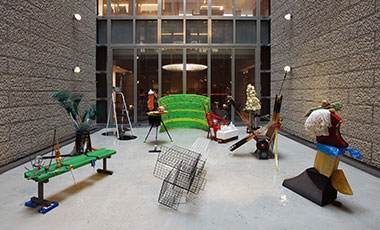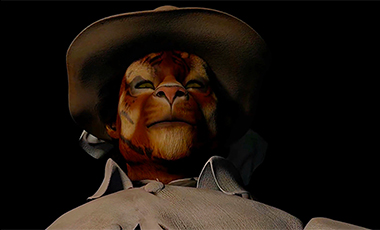
《Art Plant Asia 2020: Hare Way Object》 took place at Deoksugung Palace in the middle of a long, peaceful autumn that felt like a reward amid the unending global pandemic. This event was reportedly dedicated to “recognizing the limitations of the Korean art market” and “assessing and expanding the status of Asian art.”1) However, the event as experienced in person can be narrowed down to “an assembly of works centering on currently active Korean contemporary artists.” Such could be expected just by looking at the spectrum of participating artists. Among the 33 individuals or groups of artists featured in the exhibition, 19 (more than half) are so-called “emerging artists” selected by the organizers of the event. Artists who played major roles in establishing the foundation of Korean modern and contemporary art made up a relatively smaller portion, and only three non-Korean Asian artists—Ho Tzu Nyen, Ho Rui An, and Royce Ng—were tantamount to the attempt for “expansion” as intended by this event. “Speculative realism,” which was purported to be the main discourse of this event, also seemed to be too faint a link to tie the artists together.
A project of such a format being subjected to a degree of criticism is perhaps foreseen. As if to recognize and accept the criticism as part of its limits, the event reintroduced emerging artists unfamiliar to the Korean art scene and hosted online and offline academic events that invited scholars from home and abroad, rather than simply and prematurely proposing art market alternatives. The event’s “Gallery Day,” which invited major galleries around Asia and introduced their activities, also seemed to project an attitude uncompromising of the event’s future strategies.

Lee Bul, 〈Chiasma〉, 2005, hand-cut polyurethane panels on aluminum armature, acrylic coating, 195x383x395cm. Image Provided by Art In Culture
The Landscape of Generational Intersection
The themed exhibition 《Hare Way Object》 unfolded inside and outside of the pyeonjeon (royal council hall) and haenggak (storage building) of Deoksugung Palace. Beginning at the haenggak near Hamnyeongjeon Hall, the introductory section of the exhibition featured a space introduced as “The Modern and Contemporary Room,” inside of which works by representative artists of Korean modern and contemporary art such as Kim Tschangyeul, Lee Ufan, and Park Seobo were propped up against the glass walls and outside of which Kim Hongjoo’s works from the 1970s were lined across three sides.2) As binary as it is, could this arrangement be interpreted as expressing that the modern zeitgeist and artistic context have ultimately been reorganized through the next generation to be carried on in a new way? Even if it can, reading between the simple parallels, the spaces in between felt too wide for the complex entanglement of culture and parallax in between to be unraveled. The same could be felt from the way works by Kim Whanki, Kim HeungSou, Nam Kwan, Park Sookeun and His Friends (around Joo-ho group: Park Dorn, Choi Young-Rim, Hong ChongMyung, and Hwang You-Yop), and Kim Heryun were presented. While it is understandable that the works of the artists, whose studies centered on composition and the surface of the canvas, would be lined up in chronological order to cast shadows on each other, the concept lacked the specific setup and explanation needed for the connection to be drawn intuitively.
In comparison, works by contemporary artists were presented in a more dynamic manner. As if to delineate the history of Korean modern and contemporary art from present day’s standpoint, works by Park Junghae, Suki Seokyeong Kang, Park Gwangsoo, Sulki and Min, Park Kyung Ryul, and Lee Woosung were arranged panoramically from the center of the haenggak. Undeniably prominent among them were Park Junghae’s 〈Bubble Mine〉 (2015), which presents imaginations of the most interesting structures feasible by intersecting vertical and horizontal lines, Suki Seokyeong Kang’s 〈Rove and Round — ear #18-02〉 (2018~2019), which seems like the result of transplanting architectural style itself into materiality, and Lee Woosung’s banner paintings, exotic landscapes that flutter away next to elegant hanok pillars.

Lee Woosung, 〈Always on My Mind〉, 2020, water based paint and acrylic gouache on fabric, 143x480cm, 110x110cm, 110x110cm. Image Provided by Art In Culture
The resonance created by the encounter between contemporary artworks—frequently associated with a boxy whitecube —and traditional architecture was the most important sight presented by this exhibition and its de facto theme. The additional interpretations that resulted are what is rather awkward. Lee Bul’s 〈Chiasma〉 (2015) inside the Seogeodang Residence, the only two-story wooden structure among the Deoksugung pyeonjeon, and Yang Haegue’s 〈Sonic Obscuring Hairy Hug〉 (2020) inside Hamnyeongjeon Hall seemed accidentally misplaced in the wrong spacetime and more lucidly pointed to the coexistence of objects and humans. Chung Heeseung’s 〈Rose is a Rose is a Rose〉 (2016) installed inside Jeukjodang Hall, known to have been the king’s bedroom, bloomed only enough for the play between its language and the perception metaphorized by the work to struggle to overcome its literal beauty. Jeonggwanheon Pavilion, where King Gojong used to enjoy his leisure time, transformed into an outdoor screening area, featuring video works by Kim Heecheon,siren eun young jung, and [Cha Jeamin](Cha Jeamin) that exposed the hidden aspects of Asian cities that have passively achieved modernization. The videos evoked a strange sense of déjà vu in juxtaposition with the videos works by Ho Tsu Nyen, Ho Rui An, and Royce Ng, which conjured imaginations of futuristic urban horror stories.
The new works produced for this exhibition were the transcendental narrators that endowed the confounded scenery of Deoksugung with subjectivity. Im Youngzoo’s 〈Cornering〉 (2020) is a sound work that borrows the form of an audio guide, which allowed for the visitors to stroll around the palace according to the directions provided by the guide, which yelled “North! East! West! South!” in turn. Central to the work is the song “One Million Roses,” originally a Latvian song that has been adapted into Korean, Russian, and Japanese and into different styles. The song suggested a renewed perception of the history of Deoksugung Palace as imbued in the architecture built in the architectural styles derived from the three countries. Around the corner toward the east end of Junghwajeon Hall, viewers ran into 〈Automatic Autonomy〉 (2020) by An Jungju and Jun Sojung. Intersecting perspectives from a camera attached to a dancer’s body and a closed-circuit camera watching the dancer from afar met with performance, sound, and the waves of pixels on the screen to be projected bare onto the real-life landscape.
Also noticeable were installations and sculptures that elaborated on discrepancies in spacetime through acute and piercing language. Choi Goen’s 〈Opercular〉 (2020) presented readymade objects in their original external states while modifying their physical properties to turn them into new structures. The objects’ original forms were the fire hydrants and the chimneys placed throughout Deoksugung Palace, designed to blend in with the traditional aesthetic of the, and the collision between the evidence of these objects’ material transformation and their traditional aesthetics proved interesting. Among works that similarly brought out new landscapes from objects maldistributed in everyday life were Koo Donghee’s 〈Soar—Horizon〉 (2020), Jung Jihyun’s 〈Every Haetae〉 (2020), and Jong Oh’s 〈Treeangle〉 (2020). In particular, 〈Soar – Horizon〉 is a sculpture that mimicked the small buoy coated with noctilucent paint floating in the pond inside Deoksugung and reinterpreted the public sculptures encroaching on Korean cities. If these sculptures and installations were affixed as part of their respective landscapes, Woo Hannah’s 〈Bag with You〉 (2020), consisting of a total of 50 varying forms/movements of wearable fabric artworks, created another landscape through live movement. Viewers could personally choose and put on one of the 50 pieces while viewing the exhibition, through which they became temporary owners of the “organ-garment-apparatuses.”

Yang Haegue, 〈Sonic Obscuring Hairy Hug〉, 2020, powder-coated stainless steel frame, powder-coated mesh, steel wire rope, black brass plated bells, metal rings, plastic twine, plastic raffia string, 200x78x80cm. Image Provided by Art In Culture
Dreaming of Reviving the Art Market
As discussed, the exhibition focused on demonstrating the kaleidoscopic aspects of Korean contemporary artists. In contrast to their active practice, the status and marketability of Asian art in the world art scene have always been problematically limited. The brief boom of the Chinese contemporary art market is often brought up in comparison to the Korean art market. This may have to do with how Chinese art historians including Gao Minglu proactively reinterpreted the stream of Chinese art through a self-established—though rather arbitrary— perspective instead of through a Western perspective.3) Of course, research by Korean art historians and curators must proceed for such a response to be viable, but more practically, the Korean and Asian art market’s expansion relies on the development of a sustainable, alternative market. Together with such a movement, drawing more detailed reinterpretations and interconnections between established and emerging Korean artists as mentioned before remains an important task. With various new attempts including online activities being spotted within the Korean art market despite unstable circumstances, it has yet to be seen if Art Plant Asia, advocating a “production plant” for East Asian cultural arts, can contribute to the revaluation of Korean contemporary art.
1)Kang Jong-hoon, 「Deoksugung Palace Turns into an Art Museum with Art Plant Asia 2020 Next Month」, 『Yonhap News Agency』, September 28, 2020, https://www.yna.co.kr/view/AK R20200928149600005.
2)Korean Contemporary Art History Research Group, 『Korean Contemporary Art 197080』, Hakyoun, 2004, p.25–44; Kim Keum-mi, “The Textuality of Lee Kun-yong’s Works in the 1970s,” 『Historical Conceptual Art in Korea 1970s to 1980s』, Noonbit Publishing Co., 2011, 176. Kim Hong Joo, an emerging artist in the 1970s, led a post-modernistic practice as part of the artist group ST. But soon, he turned to hyper-realistic painting as his main mode as he sought to pioneer a unique course of work.
3)Gao Minglu, trans. Lee Juhyun, 『Beyond the Wall: The History of Chinese Contemporary Art』, Mijinsa, 2009. In his book, Gao argues that Chinese performing arts are more anti-aesthetic than Western conceptual art, presupposing that Chinese modernity is not a concept specific to a certain period as is Western modernism but a zeitgeist unique to China.
《Art Plant Asia 2020》 was an art festival co-organized by Seoul Jeong-dong East Asian Art Festival Committee and the Jung-gu Office dedicated to nurturing Jeong-dong into a hub of East Asian art. This event was composed of a themed exhibition, an academic seminar, and a “Gallery Day,” and the themed exhibition 《Hare Way Object 》featured works by 11 Korean modern artists (groups), 19 Korean contemporary artists (groups), and three non-Korean Asian artists, displayed among the nooks and crannies of Deoksugung Palace.
※ This article was originally published on the DEC 2020 issue of Art In Culture and is provided by the Korea Art Management Service under a content provision agreement with the magazine
Goeun Song
Curator


